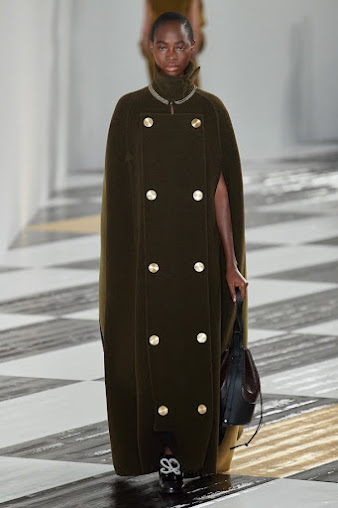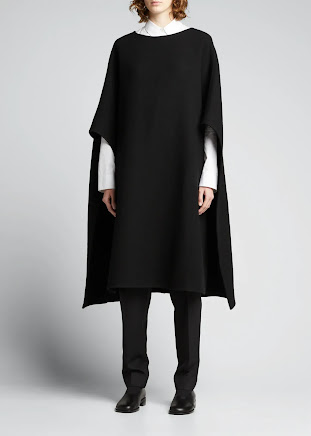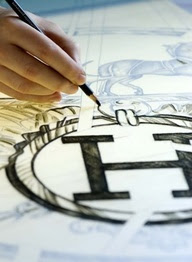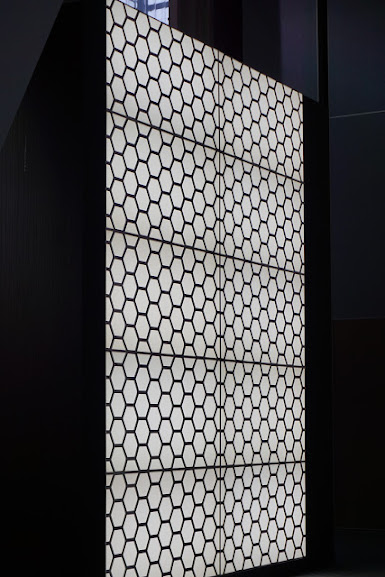FASHION POST: My Love of Capes, the history of this mysterious garments
Loewe via Vogue
FASHION FORWARD 2022:
WHY I LOVE A GOOD CAPE
IN MY WARDROBE
"Capes were common in medieval Europe,
especially when combined with a hood in the chaperon.
They have had periodic returns to fashion -
for example, in nineteenth-century Europe.
Roman Catholic clergy wear a type of cape
worn for formal events outside a ritualistic context." - Wikipedia'

Audrey Hepburn (1957) in Funny Face movie wearing Givenchy
Something about a good cape has me smitten. I own a velvet Burberry cape and as warmer days of winter arrive (just before spring or even late fall) I don this lovely garment for evenings out in New York City. Or, if I'm heading out to a cocktail party and I want to feel extra chic. When I do, I feel like Audrey Hepburn in one of her fashion forward movies. (Speaking of Audrey, designer Hubert de Givenchy created a silk cape she wore in Funny Face in the 1950s and that image is brandished in my brain as one of the best fashion moments in cinematic history) Why do I love them, you may ask? Well, for starters they create a lovely silhouette, they're easy to wear and don't mess up you're wearing underneath, and they're perfect for city living where one is indoors and outdoors often many times in a day. I dislike wearing big puffy coats and many layers in New York City, so a cape is perfect. I got to wondering about the history of this beautiful fashion statement.
history of capes:
The word Cape is an ancient French word, “cloke,” from the Latin word “cloca.” Earlier writings call capes as mantels, while some refer to them as cloaks. In medieval times, cloak makers were called “mentel makers.” Monks wore capes with hoods that draped down to their waist, and Queen Elizabeth wore floor-length capes with detailed stitching. Later in history capes had more stitching, became shorter and more or less a fashion statement but all depending upon the wearers’ station in life and status. The Victorian era brought capes in fashion and now it was the woman who wore them primarily. High society ladies in the 18th century, donned bold red ones called Scarlet Capes. These toney capes were worn at social gatherings, in church and even part of their wedding dress, and only the finest ladies were privileged to wear such a fashion statement. Made from cotton, velvet and satin some had furn linings and although not floor length they were longer then the capes of today to properly cover a woman’s dress.
The word Cape is an ancient French word, “cloke,” from the Latin word “cloca.” Earlier writings call capes as mantels, while some refer to them as cloaks. In medieval times, cloak makers were called “mentel makers.” Monks wore capes with hoods that draped down to their waist, and Queen Elizabeth wore floor-length capes with detailed stitching. Later in history capes had more stitching, became shorter and more or less a fashion statement but all depending upon the wearers’ station in life and status. The Victorian era brought capes in fashion and now it was the woman who wore them primarily. High society ladies in the 18th century, donned bold red ones called Scarlet Capes. These toney capes were worn at social gatherings, in church and even part of their wedding dress, and only the finest ladies were privileged to wear such a fashion statement. Made from cotton, velvet and satin some had furn linings and although not floor length they were longer then the capes of today to properly cover a woman’s dress.
capes never seem to go out of fashion:
The cape is a timeless fashion staple and since the 20th century, designers have been including capes (and versions of capes) in their couture and ready to wear collections keeping capes current. Designers such as Lanvin, Balenciaga Chanel, Givenchy and Dior have kept capes in our closets.
Happy Nesting, XO Tamara
Christian Dior 1960's via Vogue
capes I want to wear this spring:
sources: Wikipedia, Cape.com, Bergdorf Goodman and Vogue magazine












